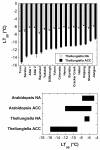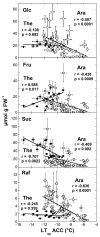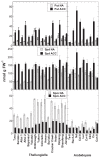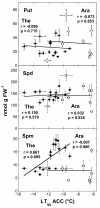Comparison of freezing tolerance, compatible solutes and polyamines in geographically diverse collections of Thellungiella sp. and Arabidopsis thaliana accessions
- PMID: 22863402
- PMCID: PMC3464606
- DOI: 10.1186/1471-2229-12-131
Comparison of freezing tolerance, compatible solutes and polyamines in geographically diverse collections of Thellungiella sp. and Arabidopsis thaliana accessions
Abstract
Background: Thellungiella has been proposed as an extremophile alternative to Arabidopsis to investigate environmental stress tolerance. However, Arabidopsis accessions show large natural variation in their freezing tolerance and here the tolerance ranges of collections of accessions in the two species were compared.
Results: Leaf freezing tolerance of 16 Thellungiella accessions was assessed with an electrolyte leakage assay before and after 14 days of cold acclimation at 4°C. Soluble sugars (glucose, fructose, sucrose, raffinose) and free polyamines (putrescine, spermidine, spermine) were quantified by HPLC, proline photometrically. The ranges in nonacclimated freezing tolerance completely overlapped between Arabidopsis and Thellungiella. After cold acclimation, some Thellungiella accessions were more freezing tolerant than any Arabidopsis accessions. Acclimated freezing tolerance was correlated with sucrose levels in both species, but raffinose accumulation was lower in Thellungiella and only correlated with freezing tolerance in Arabidopsis. The reverse was true for leaf proline contents. Polyamine levels were generally similar between the species. Only spermine content was higher in nonacclimated Thellungiella plants, but decreased during acclimation and was negatively correlated with freezing tolerance.
Conclusion: Thellungiella is not an extremophile with regard to freezing tolerance, but some accessions significantly expand the range present in Arabidopsis. The metabolite data indicate different metabolic adaptation strategies between the species.
Figures








Similar articles
-
Clinal variation in the non-acclimated and cold-acclimated freezing tolerance of Arabidopsis thaliana accessions.Plant Cell Environ. 2012 Oct;35(10):1860-78. doi: 10.1111/j.1365-3040.2012.02522.x. Epub 2012 May 10. Plant Cell Environ. 2012. PMID: 22512351
-
Time-dependent deacclimation after cold acclimation in Arabidopsis thaliana accessions.Sci Rep. 2015 Jul 15;5:12199. doi: 10.1038/srep12199. Sci Rep. 2015. PMID: 26174584 Free PMC article.
-
Natural Variation in Freezing Tolerance and Cold Acclimation Response in Arabidopsis thaliana and Related Species.Adv Exp Med Biol. 2018;1081:81-98. doi: 10.1007/978-981-13-1244-1_5. Adv Exp Med Biol. 2018. PMID: 30288705 Review.
-
Acquisition of freezing tolerance in Arabidopsis and two contrasting ecotypes of the extremophile Eutrema salsugineum (Thellungiella salsuginea).J Plant Physiol. 2015 May 15;180:35-44. doi: 10.1016/j.jplph.2015.03.011. Epub 2015 Apr 1. J Plant Physiol. 2015. PMID: 25889872
-
Learning from evolution: Thellungiella generates new knowledge on essential and critical components of abiotic stress tolerance in plants.Mol Plant. 2009 Jan;2(1):3-12. doi: 10.1093/mp/ssn094. Mol Plant. 2009. PMID: 19529830 Free PMC article. Review.
Cited by
-
Pleiotropic effect of chromosome 5A and the mvp mutation on the metabolite profile during cold acclimation and the vegetative/generative transition in wheat.BMC Plant Biol. 2015 Feb 19;15:57. doi: 10.1186/s12870-014-0363-7. BMC Plant Biol. 2015. PMID: 25848884 Free PMC article.
-
Taxonomy and systematics are key to biological information: Arabidopsis, Eutrema (Thellungiella), Noccaea and Schrenkiella (Brassicaceae) as examples.Front Plant Sci. 2013 Jul 31;4:267. doi: 10.3389/fpls.2013.00267. eCollection 2013. Front Plant Sci. 2013. PMID: 23914192 Free PMC article.
-
Drought-hardening improves drought tolerance in Nicotiana tabacum at physiological, biochemical, and molecular levels.BMC Plant Biol. 2020 Oct 23;20(1):486. doi: 10.1186/s12870-020-02688-7. BMC Plant Biol. 2020. PMID: 33097005 Free PMC article.
-
Halophytism: What Have We Learnt From Arabidopsis thaliana Relative Model Systems?Plant Physiol. 2018 Nov;178(3):972-988. doi: 10.1104/pp.18.00863. Epub 2018 Sep 20. Plant Physiol. 2018. PMID: 30237204 Free PMC article. Review.
-
Genomic Variation Landscape of the Model Salt Cress Eutrema salsugineum.Front Plant Sci. 2021 Aug 17;12:700161. doi: 10.3389/fpls.2021.700161. eCollection 2021. Front Plant Sci. 2021. PMID: 34484264 Free PMC article.
References
-
- Guy CL, Kaplan F, Kopka J, Selbig J, Hincha DK. Metabolomics of temperature stress. Physiol Plant. 2008;132:220–235. - PubMed
-
- Xin Z, Browse J. Cold comfort farm: the acclimation of plants to freezing temperatures. Plant Cell Environ. 2000;23:893–902.
-
- de Meaux J, Koornneef M. The cause and consequences of natural variation: the genomic era takes off! Curr Opin Plant Biol. 2008;11:99–102. - PubMed
-
- Koornneef M, Alonso-Blanco C, Vreugdenhil D. Naturally occurring genetic variation in Arabidopsis thaliana. Annu Rev Plant Biol. 2004;55:141–172. - PubMed
Publication types
MeSH terms
Substances
LinkOut - more resources
Full Text Sources

